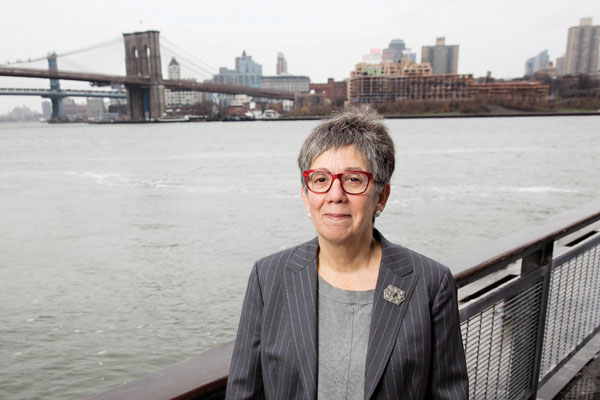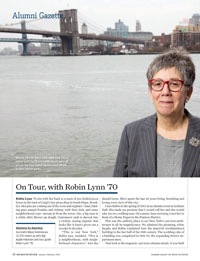Alumni Gazette
 WALKS ON THE WILD SIDE: New York City native Lynn has given hundreds of tours all across the city, exploring sites well off
the beaten tourist paths. (Photo: Shannon Taggart for Rochester Review)
WALKS ON THE WILD SIDE: New York City native Lynn has given hundreds of tours all across the city, exploring sites well off
the beaten tourist paths. (Photo: Shannon Taggart for Rochester Review)Robin Lynn ’70 sits with her back to a stack of pre-folded pizza boxes in the back of Luigi’s tiny pizza shop in South Slope, Brooklyn. Hot pies are coming out of the oven and regulars—loud, balding guys named Frankie and Johnny with their kids, and some neighborhood cops—stream in from the street. Gio, a big man in a white shirt throws up dough. Customers’ cash is shoved into a rickety, analog register that looks like it hasn’t given out a receipt in decades.
“This is real New York,” Robin says, satisfied. “This is a neighborhood, with neighborhood characters.” And she should know. She’s spent the last 45 years living, breathing and loving every inch of this city.
Alumna to Alumna
Journalist Maya Dukmasova ’12 (T5) meets up with Big Apple historian and tour guide Robin Lynn ’70.
I met Robin in the spring of 2012 at an alumni event in Gotham Hall. She made me promise that I would call her and she would take me on a walking tour. On a sunny June morning, I met her in front of a Home Depot in the Flatiron District.
This was the unlikely place to see New York’s cast iron architecture in all its magnificence. We admired the gleaming, white façade, and Robin explained how the material revolutionized building in the last half of the 19th century. The wedding cake of a building was completed in 1892 for the expanding Stern’s department store.
“Just look at the magnetic cast iron columns inside. It was built so it could have large plate glass windows letting light in. It’s the pre-electric golden era!”
Instead of elegant doormen in top hats who once welcomed shoppers into Stern’s, we entered past men and women in orange aprons. Weaving by the columns and through rows of lumber, Robin led me to the center of the building. An airshaft capped with a sprawling skylight pierced its six floors. Here in the heart of a Home Depot we marveled at this feat of structural engineering, basking in the indoor light and air that once made the Stern brothers rich.
For Robin, who was born and raised here, New York City is an endless onion. “I wish residents could walk down the street and have, I don’t know, X-ray vision into the past, to peel back the layers,” she says.
Since she graduated from Rochester, Robin has held an array of jobs that allowed her to peel back layers and create context for the built environment of the city.
In the 1970s she worked for the New York State Council on the Arts, where she distributed grants to visual arts organizations and simultaneously worked on her master’s degree in art history at Columbia. Some years later she worked for a consortium of educational and cultural institutions under a grant from the National Endowment for the Humanities to revive Brooklyn through history projects.
“When I worked [in Brooklyn] in the late 1970s people were running for their lives,” she recalls. “We did exhibitions and posters and lectures and now 35 years later, all I can say is I must have done a helluva good job! Look at this borough, it’s now the hippest!”
Robin had no intention of migrating to the suburbs when the first of her three children was born in 1979. She and her husband eventually settled on Roosevelt Island, a quiet residential area in the middle of the East River. As her kids grew up, Robin was organizing and giving tours of the city for the Municipal Art Society. She’s worked with groups ranging from 15,000 to two and covered every inch of the city. “I know Manhattan like a college campus,” she says, “I don’t know anywhere in Manhattan that I don’t feel at home.”
We came out of the Home Depot and walked south down Avenue of the Americas. Robin told me about all the buildings we passed. The stretch of street, called the Ladies’ Mile, was once home to the most glamorous department stores and boutiques in the country. We briefly stepped into the Church of the Holy Communion, an Episcopal Church complex built in the 1840s. The building has had many lives and Robin knows them all.
By the 1970s, the complex was sold, and the church became a cultural center for poetry readings and lectures on world religions. It was sold again and used for drug rehabilitation programs.
In the 1980s the church became a famously decadent night club. Between 1983 and 2007 the Limelight (and its successor, Avalon), renowned for drug busts, hosted dance parties and performers from Whitney Houston to Marilyn Manson. Robin explained all this as we wandered through racks of expensive knitwear. The church complex is called Limelight Marketplace today.
Even though she still gives tours on occasion, in recent years Robin has transitioned more to writing. She worked with New York’s “dean of walking tours” Frances Morrone on her first book, Ten Architectural Walks in Manhattan in 2009. Their second collaboration produced Guide to New York City Urban Landscapes in 2012, a book focused on parks and green spaces in the city.
Recently Robin made a gift to establish a lecture series at the University on architectural history. She hopes the series will bring a greater appreciation for the city of Rochester to the campus and create conversations between students and experts, and among departments about new ways to discover and appreciate built environments.
The most recent time I saw her, Robin invited me for a walk among the dead. We met at dusk at the ornate gate of the Green-Wood Cemetery in Brooklyn—home to a colony of South American monk parakeets, one of the many unique features of the gigantic cemetery.
As we meandered past sprawling weeping willows and pathways that erased into darkness I told Robin that I thought of her as a real New Yorker. She hesitated. She didn’t seem quite comfortable with the label. “A real New Yorker is someone who if they would like to smell the grass has Green-Wood Cemetery as their option,” she said after a pause. A real New Yorker is too busy living to pay close attention to this marvelous city.
—Maya Dukmasova ’12 (T5)

